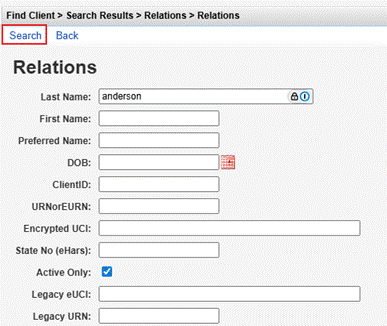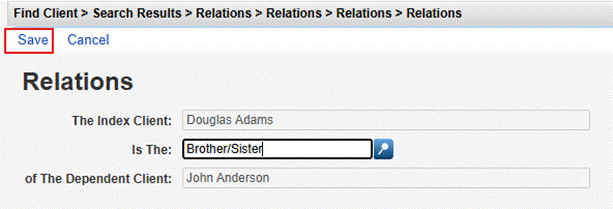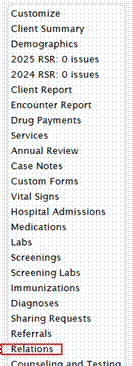 36
36
Users can track related clients using the Relations tab in client records, including:
- Aunt/uncle
- Brother/sister
- Child
- Cousin
- Grandchild
- Grandparent
- Neice/Nephew
- Not Family
- Other
- Parent
Clients are linked by appending a relationship, and the link is removed by detaching the relationship.
Add Relations to Identify Links Between Client Records
Relations are set up by identifying a relational link between two client records in CAREWare. Either of the client records can be used for setting up the relationship. For example, the process can start with the parent to create a relationship with a child, or vice versa. The primary client is referred to as the index client, and the secondary client is referred to as the dependent client.
1. Open the record of the index client.
2. Click Relations.

3. Click Append Relationship to add a new relationship record.

View Relationship: View the relationship for an existing Relations record.
View Dependent: Open the dependent (i.e., secondary) client’s record.
Append Relation: Add a new Relations record.
Detach Relation: Remove an existing Relations record, as well as the relational link between the two clients.
Help: Access the Knowledge Base article for Relations.
Print or Export: Print or export the list of relation records.
Hide/Show Columns: Hide or show columns in the list of relations.
4. Search for the dependent (i.e., secondary) client.

5. Highlight the secondary client’s name in the list and click Append Selected.

6. Choose the type of relationship in the Is The field and click Save.

The Relations list shows the relationship, as well as the appended client’s name, date of birth, and other information.

CAREWare automatically adds the corresponding Relations record to the dependent client.

Removing a Relational Link Between Two Client Records
1. Click Relations in the index or dependent client record.

2. Highlight the existing relations record and click Detach Relation.

CAREWare removes the relations record in the index and dependent client records.






